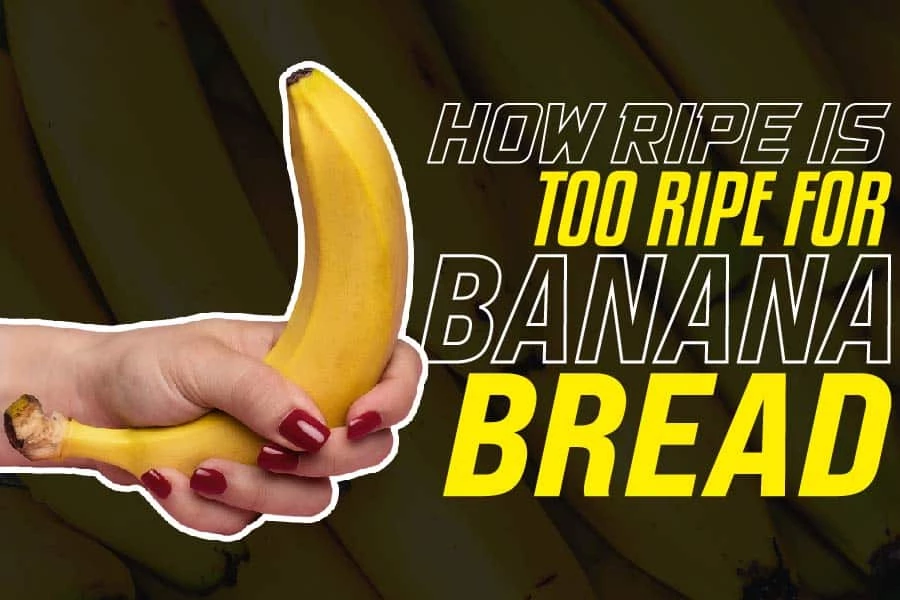Baking is more than just cooking. It’s not just about mixing sugar, eggs, and flour to make cakes and cookies. It’s much more and has a science to it. And that’s why every ingredient had a specific measurement.
Beyond measurement, each ingredient has its suitable condition for a perfect end-product. The same applies to flour, eggs, sugar, and even water. Bananas are also not left out.
It’s common knowledge that you need a ripe banana for baking. But it may not be obvious when you’re not sure of how mature they should be.
This post explains how ripe bananas should be for banana bread. You’ll also learn how to ripen banana bread. And in case you don’t intend to use them yet, you’ll know how to keep them from ripening fast. Let’s dive in!
How Ripe Is Too Ripe For Banana Bread
Well, there’s no “too ripe” when baking banana bread. You may have to leave the bananas to become overripe if they are ripe but not ripe enough. Most times, bananas that are too-ripe-to-eat are great for baking.
If you buy ripe bananas, you may have to wait for a few days to let them overripe. Sometimes, you may even wait for a week or two till they become “black bananas.” The riper, the better, and the more flavors you’ll get from your banana bread.
However, you have to be careful. Ensure that the overripe bananas don’t get rotten. If you don’t want to use them yet, store them properly. It can be painful to discard such yummy fruit when you could easily prevent them from getting rotten.
How To Ripen Bananas Faster For Banana Bread
What then if you bought a bunch of bananas that are not ripe enough for banana bread? How can you speed up the ripening process? Well, that happens. And if it comes to that, here are two ways to hasten the process.
Use a paper bag:
You can make ripening faster by using a paper bag. All you have to do is put the bunch into a paper bag. That helps trap the ethylene gas in the bag, making it easier for the fruit to ripen. It may take a day or two, or even overnight.
You can also use a perforated plastic bag for this. But ensure that the bag you use won’t trap moisture. That’s because bananas give off water. Keep checking to see the progress of the ripening.
Cook them:
Another way to ripen your bananas is to cook them. However, it doesn’t “ripen” them; instead, it makes them soft enough for baking.
Before using this method, make sure the bananas are sweet and yellow. It ensures they already have the needed flavor even though not soft enough.
Heat your oven to 160 or 180-degree Celsius. Then place the bananas inside and let them cook for about 30 to 40 minutes. They’ll become black, very soft, and may become a bit sweeter. Ensure you keep an eye on them while they cook, as they may burst when they overcook.
How To Keep Bananas From Ripening Too Fast
Hang them:
Don’t store bananas with other fruits or produce; instead, hang them away. That’s because most fruits release ethylene gas as they get ripe. Some of them include peaches, apples, avocados, and figs. You can buy a banana hanger to make it easier to store.
Hanging bananas also prevents bruising. That way, the flesh won’t get exposed to oxygen – another culprit that ripens them.
You can easily hang your bananas to keep them from ripening too fast. No wonder grocery stores hang bananas.
Place them in your refrigerator:
Another way to prevent bananas from ripening too fast is to put them in your fridge. Once you notice that they’re ripe, you can pop them in your refrigerator. The cool temperature will slow down the ripening process.
Don’t worry if the peel changes color to brown or even black. It won’t affect the flavor or texture of the fruit inside. The color change is a result of peel pigment.
Bath them in vinegar:
Consider bathing the bananas in vinegar to stop the ripening process. It’ll keep the fruit from turning brown. You can dilute the vinegar with water before using it. And when you’re ready to consume the bananas, rinse them well to get rid of any taste of vinegar.
Use plastic wrap to wrap the stems:
You can use plastic wrap to cover the banana crown. Some bunch you purchase from a grocery store may come with their crowns already wrapped in plastic wraps. You can keep them that way or add more at home. Tinfoil can also work as much.
The banana stem tends to release much ethylene gas, which increases the ripening rate. Hence wrapping that end slows down the process. You can also pull each banana away from the bunch carefully. And ensure the crown stays on it. Then wrap their tops separately.
Add citrus juice:
If you’ve peeled the banana, add citrus juice to it. Doing so will help preserve its freshness. You can use lime or lemon juice for this. It minimizes the oxidation process. You also can dilute the juice with water before adding.
If the banana is whole or two halves, brush the citrus juice on it. But if you slice the fruit, add one or two teaspoons of citrus juice to it.
It’s important to note that citrus juice can affect the fruit’s flavor. Your banana may taste a bit tart.
Freeze them:
If you intend to keep the bananas for an extended period (more than a few days), then freeze them. Freezing bananas makes them last longer than refrigerating them. They may last for up to 30 days when frozen.
Use freezer-safe bags before freezing the bananas to prevent freezer burn. You can defrost them at room temperature when you’re ready to use them.
Note that you can freeze both peeled and unpeeled bananas. However, the unpeeled ones will have their peels turning completely black. And that’s okay. But don’t try to peel them when they’re still frozen. Defrost first before peeling. Or peel them before freezing.
Freezing can reduce the nutritional value of bananas. To avoid that, store them at zero-degree Celsius or lower.
When Is Overripe Banana Unsafe To Eat?
An overripe banana becomes unsafe to eat when it gets rotten. There’s a thin line between an overripe banana and a rotten one. As the fruit gets ripe, ethylene gas continues to aid the process till it becomes overripe. And after that, it tends towards rot and becomes a mushy mess.
Bananas usually get rotten because of mold. You have to be careful, as they can be dangerous. Some of them produce toxins that can cause organ damage.
Sometimes molds may also lead to allergic reactions or respiratory problems. In some cases, they may cause symptoms associated with brain illnesses or neurodevelopmental disorders.
There are ways to know when a banana gets rotten. Here are some of them.
Moldy smell:
One way to know that a banana is rotten is when it smells stale. It usually occurs when it rots inside, such that the peel may look okay. So, if you perceive a terrible or strange odor, then it is. Sometimes, you may smell a fermented or mildew scent.
If you notice mold on your banana, discard it properly. Use plastic or paper to wrap it before disposing of it to protect your children or pets.
Extensive browning and moldy skin:
Another way to know a rotten banana is its moldy skin with extensive browning.
An overripe banana can have brown or black skin. However, it’s primarily rotten if you notice mold on the skin. As such, it’s best not to consume it. That’s because it’s most likely bad inside.
Mushy feel:
A rotten banana will have a mushy feeling when you press it gently. Ripe bananas feel soft to the touch. Touching it will help you know how firm the banana is.
Note that overripe bananas also feel mushy and so you may need other signs to determine if it’s rotten.
Oozing liquid:
It’s best not to eat your banana if you notice that it’s oozing liquid. However, it may still help bake some recipes. But check to be sure it’s not rotten before using it.
Extensive dark spots in fruit:
Your banana may be rotten if it has extensive black or brown streaks in the fruit. You have to remove the peel and look at the fruit inside. If you notice dark spots or mold on it, please throw it away.
Funny taste:
If your banana has a funny taste, then it’s time to dispose of it. You have to peel the banana and take a little bite. If it tastes off, then throw it away. If the taste is okay, then it is.
Conclusion
Bananas can’t be too ripe for banana bread. It’s best to use them when they’re overripe. That’s when you can get all the flavor and yummy tastes. But be careful when using overripe bananas and ensure they’re not rotten.
If you’re not ready to use your ripe bananas, store them properly to avoid spoilage. You can hang them, place them in a fridge, or even freeze them. That way, they can stay long enough to use them when you want.
 Being Human
Being Human




